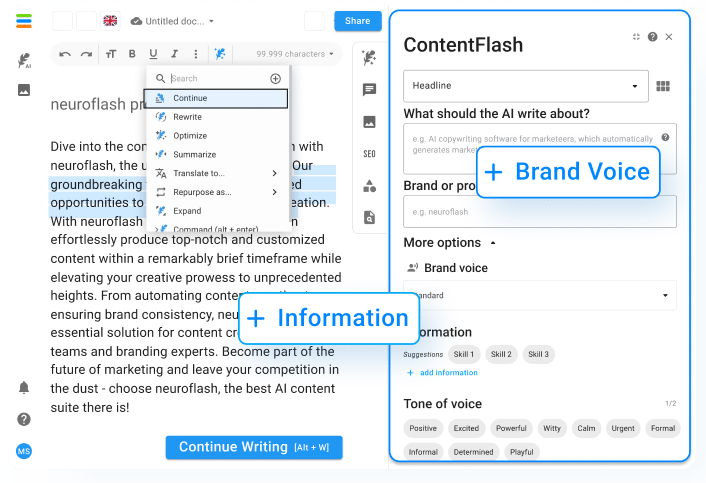Having a successful marketing strategy is crucial for any business plan. Neuroflash can help you identify your target market, analyze your competitors, create a unique brand identity and positioning, develop lead generation and sales strategies, monitor your marketing budget and metrics, and more.
Target Market Analysis
Before creating a marketing strategy, it’s essential to identify and understand your target audience. This includes demographics, psychographics, behaviors, and needs. By knowing your target market, you can tailor your messaging, products/services, and advertising to appeal to them specifically. To conduct a target market analysis, use tools like surveys, social media insights, Google Analytics, and market research reports. These can help you gather data and insights about your ideal customer profile and create buyer personas. You can then use this information to segment your audience and develop more effective marketing strategies.
To learn more about conducting market research, check out this article by Neuroflash.
It’s important to remember that your target market may change over time, so it’s crucial to constantly monitor and analyze your audience’s behavior and needs.
Competitive Analysis
An effective marketing strategy also requires analyzing your competition. This includes researching their products/services, pricing, messaging, target audience, and online presence. By understanding your competitors, you can identify their strengths and weaknesses and find ways to differentiate your brand and stand out in the market. You can also use this information to create a unique selling proposition (USP) that highlights your brand’s unique benefits and offerings.
Tools like SEMrush, SimilarWeb, and Google Trends can be useful for conducting competitive analysis and staying up-to-date with market trends.
For more information on the advantages and disadvantages of working with a digital marketing agency for competitive analysis, read this article by neuroflash.
Branding and Positioning
Once you have identified your target audience and competition, you can begin developing your brand identity and positioning. This includes creating a brand name, logo, tagline, and messaging that align with your audience’s needs and preferences. Your brand identity should be consistent across all channels and touchpoints, including your website, social media, advertising, and packaging.
You should also determine your brand’s positioning in the market. This includes defining what makes your brand unique and different from your competitors. Your brand positioning should be based on your USP and should appeal to your target audience’s emotions, values, and aspirations.
For more information on creating a unique brand identity, check out this article by neuroflash.
Lead Generation and Sales Strategy
Lead generation is the process of attracting and converting potential customers into actual customers. This involves creating a strong online presence and using various marketing channels such as social media, email marketing, content marketing, search engine optimization (SEO), pay-per-click (PPC) advertising, and more. It’s important to use a combination of these tactics to reach your target audience effectively.
Once you have generated leads, you need to convert them into sales. This involves developing a sales strategy that includes a clear sales funnel, pricing strategy, targeting high-value customers, and providing excellent customer service to retain customers and encourage repeat business.
For more information on automating your SEO and improving your marketing funnel, check out this article by neuroflash.
Marketing Budget and Metrics
Creating a marketing budget is crucial for allocating resources effectively and measuring ROI. Your budget should include expenses such as advertising, social media management, website maintenance, and more. It’s also important to track and analyze your marketing metrics regularly to determine the effectiveness of your strategies and make data-driven decisions. Key metrics to monitor include website traffic, conversion rates, cost per lead or acquisition, lifetime value of a customer, and more.
Useful Tips
- Ensure your marketing goals align with your overall business objectives.
- Stay up to date with the latest marketing trends and technologies.
- Don’t underestimate the importance of customer experience.
- Track and analyze your data to fine-tune your marketing approach.
- Consider partnering with marketing experts, such as Neuroflash.
Related Questions
How can you determine the target market for your business?
To determine your target market, consider the demographics, psychographics, behaviors, and needs of your ideal customer profile. Use tools like surveys, social media insights, and market research reports to gather data and create buyer personas. Continuously monitor and analyze your audience’s behavior and needs to adjust your target market over time.
What are some effective ways to research and analyze your competitors?
Effective ways to research and analyze competitors include researching their products/services, pricing, messaging, target audience, and online presence. Use tools like SEMrush, SimilarWeb, and Google Trends to stay up-to-date with market trends. This information can be used to differentiate your brand, create a unique selling proposition, and create effective marketing strategies.
What methods can you use to generate leads and increase sales?
Methods to generate leads and increase sales include using social media, email marketing, content marketing, SEO, PPC advertising, and more. Develop a strong online presence and create a clear sales funnel, pricing strategy, and customer retention plan.
How do you measure the success of your marketing efforts through metrics?
Measure the success of your marketing efforts by tracking metrics such as website traffic, conversion rates, cost per lead or acquisition, lifetime value of a customer, and more. These metrics can be used to make data-driven decisions and adjust your marketing approach as needed.
How does a marketing strategy in a business plan evolve over time as the business grows and changes?
A marketing strategy in a business plan should be continually monitored and adjusted based on changes in the market, competition, and internal business operations. This can include adjusting target audience, marketing channels, messaging, and more.
Conclusion
In today’s competitive market, having a well-designed and executed marketing strategy is vital to the success of any business plan. A strong marketing strategy can help you identify and target your ideal customers, differentiate your brand from the competition, and increase sales and revenue. By following the tips and tools provided by Neuroflash, you can develop a marketing strategy that is tailored to the unique needs and goals of your business.
Remember that creating a marketing strategy takes time and effort, and it is an ongoing process that requires continuous monitoring and adjustments. By staying up-to-date with the latest marketing trends and technologies and tracking your marketing metrics closely, you can fine-tune your approach and achieve your business objectives.
If you are new to marketing or don’t have the bandwidth to take on the task of creating and executing a marketing strategy, consider partnering with a marketing agency like Neuroflash. With years of industry experience and a team of experts in their fields, they can help you develop and implement a customized marketing strategy that will drive results.
In conclusion, a successful marketing strategy is critical to the growth and success of your business. With careful planning, execution, and monitoring, you can develop a strategy that will help you reach your business goals and stand out from the competition. So, take the first step today and start creating your marketing strategy!


















